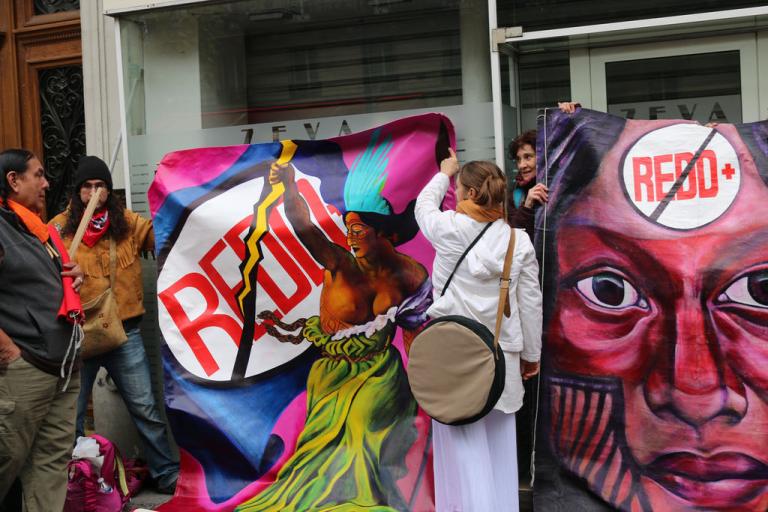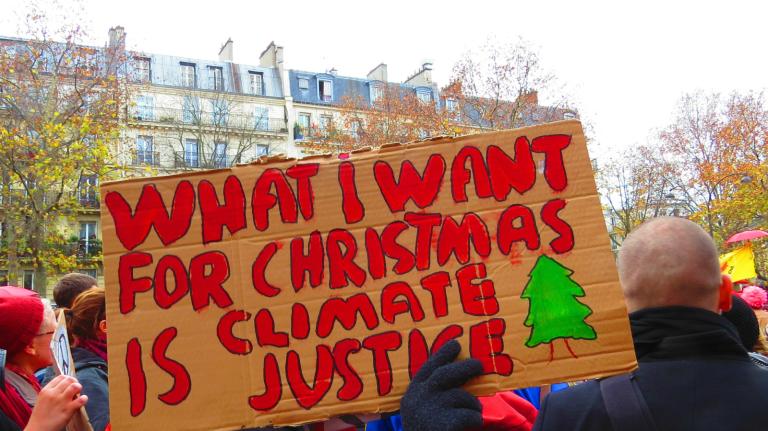PARIS, France — From reading reports in the press — and hearing complaints from Republicans always looking for an excuse to do nothing about climate change — you might get the sense that developing countries are the impediment to reaching a strong climate agreement in Paris. Traditionally the subject of such handwringing was China, but as it has grown richer it has become more proactive about fighting climate change, so the new scapegoat is India.
On Monday, a New York Times headline declared that Indian Prime Minister Narendra Modi “could make or break Obama’s climate legacy,” while a Wall Street Journal headline said that India is “a focus of [the] Paris climate talks.” The Times wrote, “Indian negotiators have publicly staked out an uncompromising position.”
India is the world’s third-largest greenhouse gas emitter, simply by virtue of having 1.25 billion people. But it is extremely poor: 300 million of its citizens lack electricity. While the U.S. has a gross domestic product (GDP) per capita of $54,630 and 16.6 tons per person of annual carbon emissions, for India those figures are only $1,596 and 1.7 tons. And so India, the Times notes, “has positioned itself as the champion of developing nations.” Specifically, that means it is offering only to reduce carbon emissions per dollar of GDP, not in total (as well as take steps such as ramping up renewables). If developing countries are to leapfrog over the dirty phase of economic growth that rich countries have gone through, India argues, that will require major investments in renewable energy — and the rich world needs to help pay for it.
But is this focus on India misplaced? It’s true that the unwillingness of developing nations to commit to future emissions cuts is a problem that stands in the way of limiting emissions. The best-case scenario based on current national pledges at the COP 21 talks in Paris is keeping warming below 2.7 degrees C, which would still lead to catastrophic climate changes, scientists say. Everyone is going to have to step it up several notches if we are to get from there down to 2 C or lower, the broadly accepted goal — and even that is higher than the 1.5 C that the most vulnerable countries are pushing for. But it’s not true that the problem of political will or lack of economic sacrifice lies with the developing nations. The problem is us, the rich countries, most especially the U.S.
Take a step back and look at the problem of climate change through the lens of equity and environmental justice. From that perspective, each country’s responsibility to cut emissions and invest in renewables at home and abroad is determined by how much climate pollution it has cumulatively emitted, and how much wealth per capita it has now.
As of 2011, the U.S. was responsible for 27 percent of the world’s cumulative greenhouse gas emissions — the largest share of any country — and the European Union collectively accounted for 25 percent. India, with a current-day population much larger than the E.U. and U.S. combined, had emitted 3 percent.
Rich countries — most especially the U.S. — are responsible for the bulk of the problem, have almost all the capacity to fix it, and should be on the hook for the vast majority of the solution.
That doesn’t mean rich countries are the only ones that need to cut emissions. Developing countries certainly need to cut them too — but rich countries need to pay up to help developing countries make those cuts.
For starters, developed countries should be committing to dramatically cut their emissions, rather than making modest cuts. Looking at their Intended Nationally Determined Contributions (INDCs), that isn’t happening. The U.S. is offering 26 to 28 percent cuts below 2005 levels by 2025. Japan offers a cut of 25 percent from 2005 levels by 2030, but that’s somewhat deceptive because it’s purchasing overseas offsets to get there, so Climate Action Tracker rates Japan’s plan as “inadequate.” Russia actually wants room for its emissions to grow. The best developed-world INDC comes from the E.U., which pledges 40 percent cuts from 1990 levels by 2030.
And at the same time, developed countries haven’t come close to contributing $100 billion per year in climate finance for poor countries, the goal set in Copenhagen in 2009 and intended to be achieved by 2020. Experts say even that goal is inadequate, in part because much of it is expected to come from the private sector, which is a shady form of accounting. The Organisation for Economic Co-operation and Development (OECD) stated in a recent paper that developed countries mobilized $57 billion in climate aid in 2013-2014, but India disputes that figure. While that specific argument is over technical measurements, there are more fundamental problems. Who knows that, say, a Western bank lending money for a clean energy project in India wouldn’t have done so without its government’s encouragement or loan guarantees? This doesn’t mean those kinds of private-sector loans aren’t useful additions, but they aren’t a substitute for direct aid.
The Civil Society Review, a coalition of environmental groups, unions, and other progressive organizations, has just produced a report analyzing each country’s INDC. It finds the rich countries are badly lacking:
The ambition of all major developed countries fall well short of their fair shares, which include not only domestic action but also international finance. Those with the starkest gap between their climate ambition and their fair shares include:
› Russia – INDC represents zero contribution towards its fair share
› Japan – INDC represents about one tenth of its fair share
› United States – INDC represents about a fifth of its fair share
› European Union – INDC represents just over a fifth of its fair share.
Part of the problem is that these countries have such large historical emissions that climate justice and equity cannot be achieved solely by cutting their emissions, no matter how rapidly. They must also offset their historical emissions with huge cash transfers to developing countries for climate mitigation and adaptation.
Listening to speeches from the representatives of developing nations in Paris, climate finance comes up again and again as their main concern. They are already feeling the effects of climate change, so they want to fight it and they want to prepare for it, but they need help. And at the same time, they want to lift their citizens out of poverty.
This is shaping up to be a major sticking point in the climate negotiations thus far. In a sign of their frustration, the Group of 77 (G77), a coalition of developing nations, publicly complained about the lack of progress on climate finance Wednesday afternoon. Nozipho Mxakato-Diseko of South Africa, the G77 chair, issued a statement saying, “The G77 and China stresses that nothing under the UNFCCC [United Nations Framework Convention on Climate Change] can be achieved without the provision of means of implementation to enable developing countries to play their part to address climate change. However, clarity on the complete picture of the financial arrangements for the enhanced implementation of the Convention keeps on eluding us.” When she says “means of implementation,” that’s a euphemism for money.
So you can see why India rolls its eyes at being chastised for its reliance on coal. Why should the country cut its emissions when the U.S. is only cutting its by one-quarter from a relatively recent baseline, even though U.S. emissions are still way higher than India’s per capita and even more so cumulatively, and even though the U.S. isn’t substantially helping India to pay for cleaner energy?
“India wants developed countries to increase their mitigation goals,” said Harjeet Singh, a New Delhi–based international climate policy manager for ActionAid, a progressive global organization, at a press conference on Wednesday. “Coal is not an obsession for India, it’s a compulsion.” What he means is that India will be happy to ditch coal for renewables if it can afford to. But for that it needs help.
“Of the big emitters, India has much lower capability to pay for mitigation than China, which has much lower capability than U.S.,” said Sivan Kartha, senior scientist at the Stockholm Environment Institute, at a press conference on Wednesday rolling out the Civil Society Review report. “The poorer countries in the aggregate have more or less put mitigation on the table that roughly corresponds to their fair share.” He doesn’t mean that every poor country has offered to cut its fair share — some have promised more, some less — but taken as a whole, they are roughly on target. “The gap from 2 C is in developed and rapidly developing countries,” says Kartha. “For rich countries, providing support through international cooperation is a core part of meeting their fair-share requirements.”
India initially toyed with the idea of offering a “conditional” alternative version of its INDC in which it would cut more emissions if it got more aid for renewable investment. It ended up not doing so, but the country still says it will up its ambition if the money it would need is forthcoming. The Associated Press reported on Wednesday:
An Indian delegate at U.N. climate talks says India will be able cut back on its carbon emissions if money is made available to boost renewable energy in an envisioned climate agreement in Paris.
“The quick answer is yes,” Ajay Mathur, the director of India’s Bureau of Energy Efficiency, told reporters. …
[A]sked whether India would cut back on coal if the Paris agreement ensures it receives international support that brings down the cost of expanding renewable energy, Mathur said: “Absolutely.”
“Solar and wind is our first commitment. Hydro, nuclear, all of these non-carbon sources are what we will develop to the largest extent we can,” he said. “What cannot be met by these would be met by coal.”
Modi has committed to delivering electricity to all 300 million Indians without it by 2022. India has ample supplies of coal, and its position boils down to this: We’re giving our people electricity, and we’ll do it with renewables if you give us the money, but we’ll do it with coal if you don’t.
Even Indian environmental activists echo the government’s position. Regarding Modi’s speech to the COP 21 on Monday, in which he laid out this stance, Sanjay Vashist, director of the Climate Action Network of South Asia, said, “He laid out the fact that India is not negotiating for a wasteful style. Developed countries are negotiating for a wasteful lifestyle. Developed countries need to make renewable energy affordable, available, and reliable in developing countries. Expecting symmetrical commitments from developed and developing countries, climate justice does not demand that. It would leave the poor behind.”
This isn’t to say that India is completely blameless for the impasse. The Indian government has taken unconstructive stances on issues unrelated to its poverty, such as being unwilling to commit to return to climate meetings every five years to strengthen its commitments. Nor has India tried to limit its demands within reason: In October, Modi said reducing India’s emissions would require $2.5 trillion in total by 2030. He might as well as ask President Obama to buy him a unicorn so that he can ride around the country carbon-free.
But none of that changes the need for developed countries to pony up more than they have. That is not just a matter of justice; it would be in everyone’s interests, as it would allow the world to come away from Paris with a set of more ambitious climate pledges from developing countries. Many developing countries other than India have made conditional pledges based on the level of climate finance.
“It’s clear there would be more ambition with more money,” says Steve Herz, senior attorney for the Sierra Club’s international climate program.
The problem is a political one, then, but it emanates from the West. Presumably the Obama administration would like to offer more climate finance, but it cannot without congressional authorization. Asking Republicans for foreign aid to solve a problem they claim doesn’t even exist would be like asking them to pay for gay weddings. Instead, the Obama administration has to fight with Congress just to make sure the GOP doesn’t strip what little climate finance the U.S. has pledged, around $500 million per year until 2020, from the budget.
Developing countries want the Paris agreement to contain more significant financing after 2020, but how can Obama promise that when gerrymandering of congressional districts has virtually guaranteed that Republicans will control of the House of Representatives until 2023? And then, in turn, how can other developed countries dig deep into their own pockets when the biggest and richest of them all, the U.S., won’t do it? The world needs U.S. leadership on this, and it isn’t getting it.



